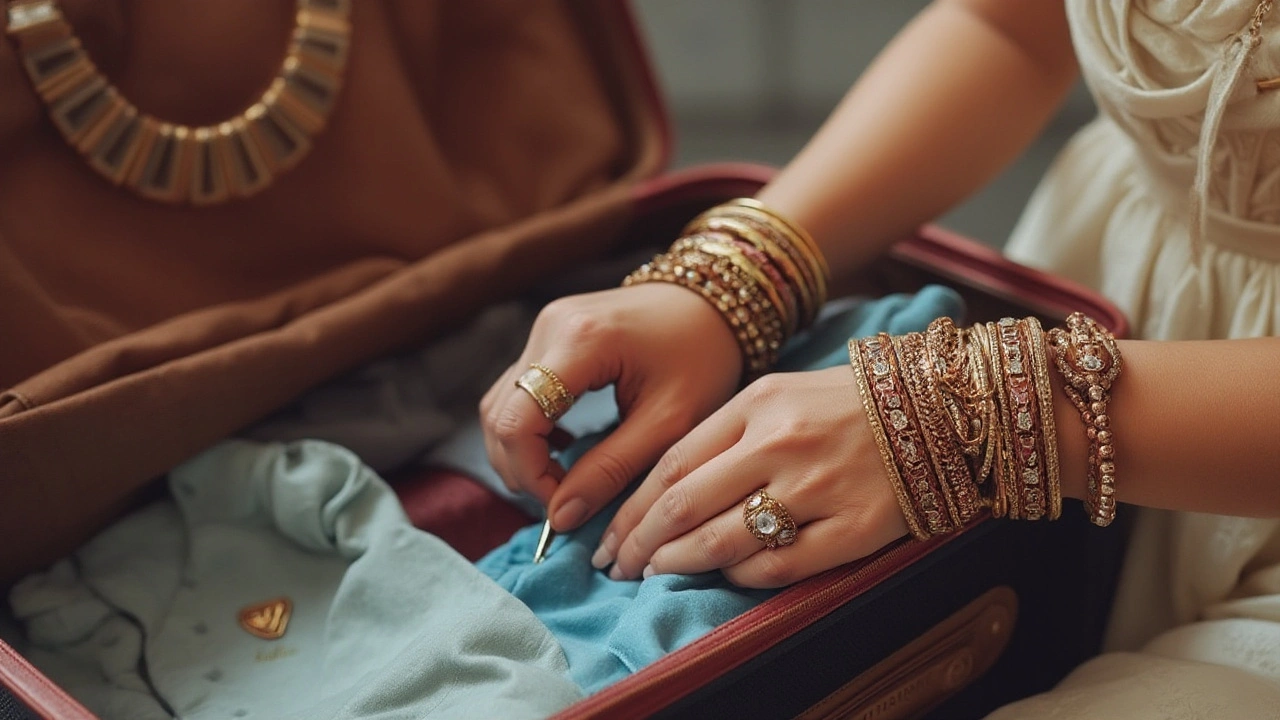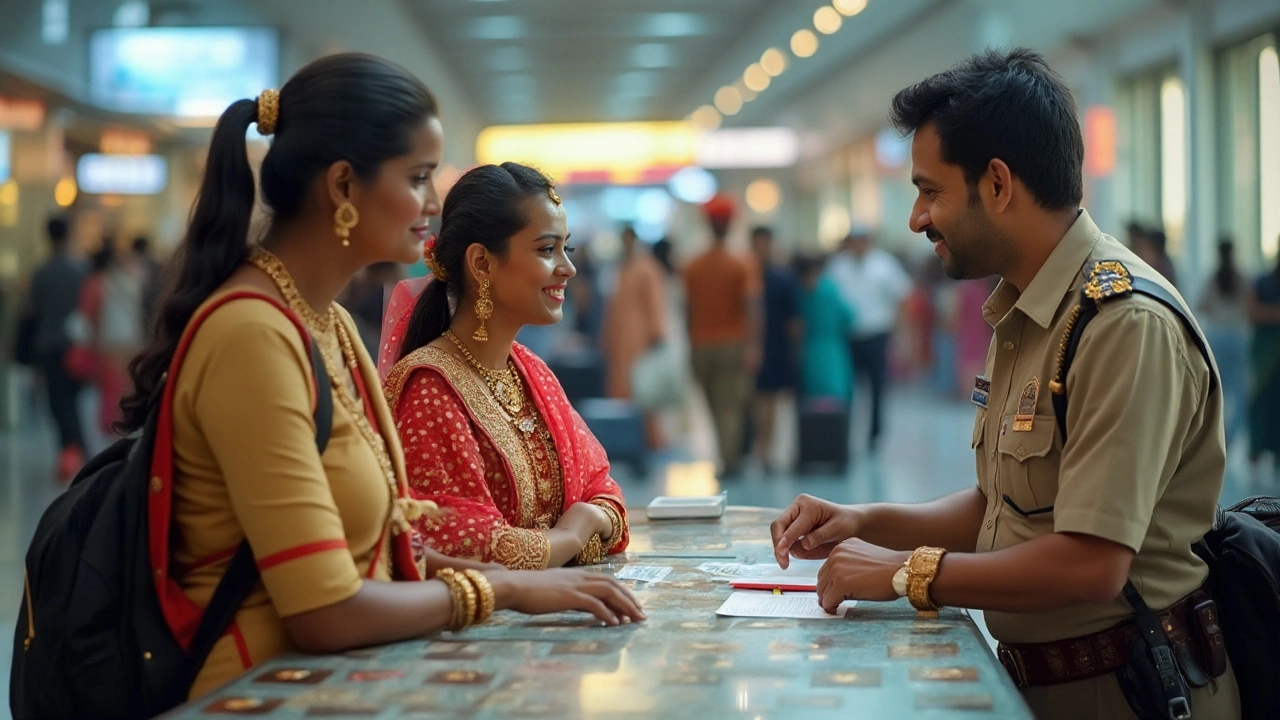When setting off for an adventure in India, the treasures you carry with you are not only keepsakes but reminders of where you've been. However, crossing borders with precious items like jewelry can be tricky. Knowing whether or not to declare these valuables at customs can make a huge difference in your journey.
Many travelers find themselves in a bind over such questions. Often hidden in the depths of travel forums or whispered among seasoned wanderers, the guidelines for bringing personal jewelry through customs might seem elusive. Yet, gaining a clear understanding isn't just for piece of mind—it's essential for a smooth trip.
Join us as we delve into the world of customs regulations in India, shedding light on what you need to declare and when you can simply breeze past the queue, ensuring both your treasures and memories return home safely.
- Overview of Indian Customs Regulations
- Do's and Don'ts for Traveling with Jewelry
- Tips for Safeguarding Your Valuables
- Real-life Traveler Experiences
Overview of Indian Customs Regulations
When traveling to India, understanding the customs regulations regarding personal belongings can make your journey stress-free and help you avoid unnecessary hassles. The rules primarily focus on maintaining balance between letting tourists bring their essentials and preventing unchecked influx of valuable items without proper dues. This balance ensures that the economic interests of the country are protected while travelers enjoy a smooth experience. Customs regulations are constantly updated to reflect the current economic landscape, which means travelers are encouraged to stay informed before each trip. Delving into these rules reveals a robust framework designed to streamline the international travel experience.
The first thing to understand about Indian customs regulations is the distinction they make between personal items for use and commercial goods. Personal jewelry, which falls under the category of personal effects, often is permissible in reasonable quantities without heavy scrutiny or taxation, provided it's clearly meant for personal use. Nevertheless, travelers must remember that regulations can vary depending on the specifics of the trip—where you're coming from, the duration of your stay, and the overall purpose of your visit all contribute to how customs will view your items. According to a recent update by the Central Board of Indirect Taxes and Customs (CBIC), tourists can bring personal jewelry worth up to Rs. 50,000 (~$670) duty-free, but it's crucial to verify the latest updates through official channels prior to traveling.
For those flying in from abroad, certain precautionary measures are advocated to ensure that one does not fall foul of customs surprises. Declaring your valuable items such as jewelry at the customs desk is a wise decision, especially if the value exceeds the stipulated norms. Misdeclaring or failing to declare can result in fines or confiscation of items, adding unnecessary stress to what should be a captivating journey. It's not uncommon for travelers to rely on seasoned advice shared on reputable travel and legal advisory forums online or to consult travel agents who specialize in Indian travel. Moreover, a spokesperson from the CBIC once stated,
"Transparency is our priority. We encourage travelers to be forthcoming about their hand-carried items, and we're committed to facilitating a seamless process for those adhering to the rules."
Travelers should also be prepared for spot checks which are random and serve to ensure compliance. Although these checks might seem tedious, they are part of a broader initiative to safeguard against smuggling and protect cultural artifacts. Customs officers are trained to assess whether items are in reasonable quantities for personal use and to differentiate between various materials and their inherent values. Tip-offs about large consignments often come from reports within the system, where meticulous note-taking and data collection play key roles. Being courteous and cooperative during these checks can make a significant difference. Having a clear inventory of personal bejeweled items, possibly accompanied by purchase receipts, can help establish the purpose and legitimacy of your belongings.

Do's and Don'ts for Traveling with Jewelry
Setting off on a journey to India while adorned with personal jewelry can offer a touch of elegance, yet it demands an understanding of customs regulations. To ensure your trip starts and ends on a high note, observing some simple do's and don'ts is crucial. Let's begin with the obvious: do wear your jewelry if it’s a must for your trip. Sporting those intricate pieces highlights your style and lets you keep them close. However, it's wise to avoid carrying too many items. Less is often more, especially when passing through international borders.
A savvy traveler always makes an inventory of the jewelry they bring, including photos and receipts if possible. Not losing track of your belongings is key; it serves as your safety net should you need to prove ownership later. It’s worth noting that personal jewelry often doesn't require declaration if it’s worn on your person, but this can vary by destination and specific airport policies. According to the Indian Bureau of Customs, travelers must declare jewelry exceeding a specified limit in weight or value.
"Always keep a copy of your jewelry's purchase receipts handy, as this can prevent unnecessary hassle at customs," advises Ramesh Shetty, an experienced travel consultant based in Mumbai.
On the flip side, there are clear don’ts: don’t pack pricey pieces in your checked luggage. Baggage handlers don’t always have the gentlest touch, and while they mean well, your treasures are safer with you. Don't overlook the importance of having a travel insurance policy that covers loss of personal belongings, particularly jewelry. It's like a soft pillow for those just-in-case moments when things don't go as planned. While the policy can never replace sentimental value, recovering financial loss can offer some solace.
In line with theft prevention, subtlety is your best friend. Wearing flashy and expensive jewelry in busy, unfamiliar public places might attract unwanted attention. Practice discretion by opting for simpler yet elegant pieces during outings. Ah, and a portable lockbox can serve as an ideal safeguard in hotels. Ensuring a secure place at your accommodation to stash your high-value items is yet another way to keep your mind at ease. Bear these do's and don’ts in mind as you glide through India's customs regulations, and your cherished pieces will likely make it back home safe and sound.

Tips for Safeguarding Your Valuables
Traveling with valuables such as jewelry requires a few extra precautions to ensure you don't just safeguard your belongings but also enjoy peace of mind. One of the primary steps is being vigilant about where and how you pack your items. Keep your jewelry in your carry-on luggage rather than checked baggage. Airlines often have restrictions for carry-ons, yet if securing your valuables is a priority, you will find a way to make room. It's crucial to keep your jewelry close, reducing the risk of loss or theft during transit.
Another essential tip involves investing in a reliable, portable safe. Many travelers overlook the advantage of having a safe that's light enough to carry yet strong enough to thwart opportunistic grabs. There are various options available in the market, from small lockboxes to tech-enabled safes that sync with your phone for added protection. It might seem like overkill—it isn’t. Seen through the lens of someone whose family heirloom went missing during a layover, preventive measures are indispensable.
Some travelers choose to buy specific travel insurance that covers personal jewelry. Policies vary, and the fine print can be tedious, but it is critical to find a plan that fits your needs. According to a recent study, approximately 30% of insured travelers reported incidents involving valuable losses that were covered by their plans. This statistic reflects the growing awareness around travel insurance. “Jewelry is more than mere adornment; it's often tied to memories and moments.” as per Elizabeth James, a travel insurance expert. These measures ensure that if the worst happens, your financial losses are minimized, and recovery is swifter.
Safeguarding your valuables also involves being discreet about what you carry. Avoid wearing flashy jewelry in public places where it could attract unwanted attention. In areas where theft is common, such a practice can be a lifesaver, quite literally. Sometimes, the prudent traveler opts to leave the most precious items at home, choosing instead to travel with pieces of less sentimentality yet equal style impact. This is a sound strategy that flies under the radar and minimizes risks.
Lastly, always be conscious of your surroundings, especially in crowded areas like markets or public transportation. Simple habits such as periodically checking your belongings, using secure locks on your bags, and wearing hidden money belts can be effective deterrence against theft. Traveling shows you wonders of the world, and by taking these steps, you ensure that neither your travel experience nor your precious items are compromised. Being aware is the first step toward keeping both your journey and belongings safe.

Real-life Traveler Experiences
Let’s dive into the world of real travelers, where stories of navigating customs with personal jewelry turn into tales of wit and wisdom. Picture Sarah, an avid traveler from New York, who recently visited India to dive deeper into the rich tapestry of its culture. While she had meticulously planned every leg of her journey, from the bustling streets of Mumbai to the tranquil backwaters of Kerala, there was one aspect she initially overlooked: the customs regulations. Sarah learned from an experienced fellow backpacker on the flight over about the nuances of declaring jewelry. This sparked a chain of events that transformed her trip into an enlightening expedition.
Upon arriving at Mumbai's Chhatrapati Shivaji International Airport, Sarah's path to understanding began. Among the bustling chaos of arrivals, she came face-to-face with the clarity of Indian customs rules. Initially unsure if her sentimental silver bracelets needed to be declared, she approached the customs officer with caution. She quickly realized how crucial it was to be informed. The officer, with a seasoned look, advised her about the 20-gram limit on gold jewelry for women travelers and assured her that silver usually wasn’t a worry. This small interaction grounded her in understanding not just the 'what' of customs rules, but also the 'how' and 'why'.
"If you're carrying something precious, knowing the rules beforehand is as important as the ticket itself," says Lisa Scott, a travel blogger known for her up-to-date tips on navigating international journey intricacies.
In another tale, we have James, a retired schoolteacher from Sydney, who had an unexpected turn of events due to his vintage watch collection. James was returning from a family wedding in Delhi, blissfully unaware of the potential for customs trouble over what he deemed simply 'fashion statements'. However, his keen eye for watches, from the elaborate Rajputana timekeepers to the sleek designs of modern Indian artisans, caught the eye of a diligent officer. James ended up spending an extended hour at the counter, explaining each piece’s sentimental value and provenance, something he now looks back on with amusement and necessary caution. He's since become an advocate for cutting through the ‘jargon’ to ensure fellow travelers remain savvy to such customs intricacies.
Many travelers like Sarah and James agree on the importance of staying informed about varying degrees of customs guidelines. Sharing their experiences has opened up invaluable discussions. For others, it's been impactful connecting the dots between these travel tales and their own itineraries. They remind us how vital it is to plan, not just itineraries but encounters with practicalities like Indian customs regulations. As Sarah and James advocate, the lessons learned from navigating these regulations often add a layer of richness, transforming travels into stories worth sharing.
